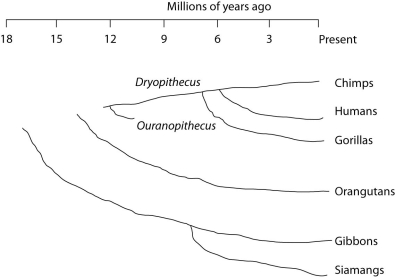Multiple Choice

Figure 26.5. Humans, chimpanzees, gorillas, and orangutans are members of a clade called the great apes, which shared a common ancestor about 18 million years ago (Figure 26.4) . Gibbons and siamangs comprise a clade called the lesser apes. Tree-branch lengths indicate elapsed time.
-The great apes comprise the family Hominidae, whereas the lesser apes comprise the family Hylobatidae. If the extant organisms on the far right side of Figure 26.5 comprise the next-most exclusive (i.e., specific) taxon, then they comprise different
A) subspecies.
B) species.
C) genuses.
D) genera.
E) orders.
Correct Answer:

Verified
Correct Answer:
Verified
Q61: Some molecular data place the giant panda
Q62: If organisms A, B, and C belong
Q63: Which eukaryotic kingdom is polyphyletic, and therefore
Q64: Three living species X, Y, and Z
Q65: Use Figure 26.1 to answer the following
Q67: If you were using cladistics to build
Q68: What is true of the phylogeny in
Q69: It was once thought that cetaceans had
Q70: Members of which kingdom have cell walls
Q71: Nucleic acid sequences that undergo few changes